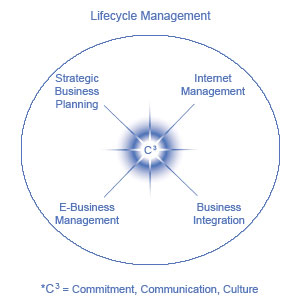|
Our Services! |
|
|
Our Partners - Alliance StrategyOur Partners - Visio, Southeastern Bell, Microsoft
Concept, Value, Capabilities
The key strategy of an organization is that it concentrates on elements of functions which add the most value. CCG’s Alliance Strategy relies on multiple partners who compete to best perform the elements of the functions that are required to deliver products and services, but are not core. By partnering with other organizations that have complementary cores, we achieve the benefits of industry scale and innovation that could not be achieved
Creating a seamless web of partnerships to bring products and services to customers can only happen when the information technology systems that each of the partners has are themselves integrated. And the only feasible way to integrate disparate IT systems is for all the organizations involved to adhere to standards. Consider the evolution of computer networks. In the past, each company had its own private data network that was often incompatible with the networks operated by its business partners. That made it very difficult and time-consuming for the two organizations to exchange information. With the Internet, companies can for the first time collaborate in real-time with their suppliers and customers. There are many other areas of information technology where standards need to be agreed upon to make it easier for companies to collaborate.
Our Network Ecosystem
None of us is as smart as all of us. - Japanese proverb
Vertical community heads (positioning), effectiveness of knowledge capture within industry, with access to a vertical industry.
The Elements of our Strategic Alliance:
It is critical to have ways to measure the results of your NVO projects, both while the projects are being implemented, and after they are completed.
Ways should be found to measure the financial impact of the changes, as well as impacts that are less tangible. Toyota Motor took this approach when it developed metrics to measure the success of revamping and automating its HR process. There are six steps in this process.
One of the challenges of devising these metrics is that some of the areas being tracked are ones that an organization may not have experience measuring. For example, the level of collaboration that exists between business partners in the networked virtual ecosystem is central to the success of strategic alliances.
New ways need to be found to measure the extent of cooperation between organizations in the NVE, and the results of such cooperation. Some possible metrics include calculating the number of cross-enterprise teams that are formed, the number of representatives from each organization, or the teams that identify the most NVE-specific process changes.
Our portfolio approach enables coordination among alliances and enhances flexibility
Our internal infrastructure supports and strives to maximize the value of external collaboration fits as they increase their level of external integration are varied. One reason is that out-tasking functions to business partners allows organizations to drastically reduce the capital and people that are needed in those areas. Tighter integration between partners and customers reduces the time it takes to respond to customer demands, design new products, and move the
Products through the distribution channel. Increased customer satisfaction affects both revenues and profits (Table 2).
Ensuring security in an environment as complex as this—where partners, people, and transactions are constantly changing—is a major challenge. To ensure that the communications network is able to meet all the demands that an NVE places on it, the network must be constantly monitored and managed. New partners, individuals, and applications will need to be added to the network and old ones removed.
Sharing data across organizations adds stress on security, reliability and timeliness.. Network
Capacity will need to increase on demand to meet increased traffic loads. Priority will need to be given to certain applications, and certain sets of data, at designated times. Maintaining adequate security is a constant concern. All of these demands make network management a high priority for alliance partners.
Strategic Business Planning
Developing the plan is actually laying out the sequence of events that have to occur for you to achieve your goal. - George L. Morrisey
Definition of corporate work flows and financial transfers Analysis of knowledge transfer implicit Communication elements required present cultural practices and use (or non-use) of electronic methods implementing strategies to business processes show the most potential? Currently, the greatest impact is in sourcing and supply chain management. That is one reason
Internet Management
Business Integration
EBusiness Management
Lifecycle Management
|

